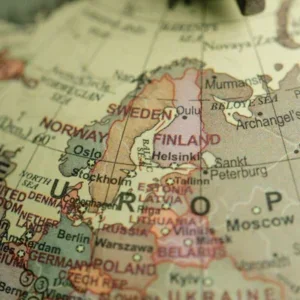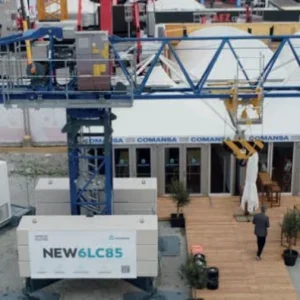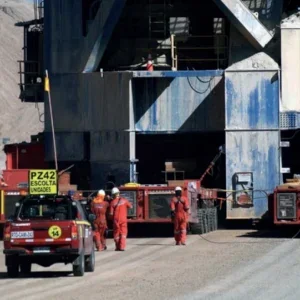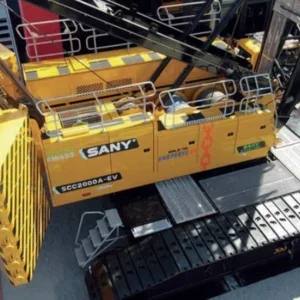Like so many of the world’s economies, business life in Russia was brought to a virtual halt in October 2008 by the global financial crisis. Funding for construction projects dried up. Come 2009, crane manufacturers either suspended production or heavily reduced output, while rental companies found themselves unable to meet loan repayments and machines were repossessed.
By mid 2010, however, there is widespread – if not universal – confidence that the economy has largely returned to health and many are reporting business activity at pre-crisis levels.
Russia’s ministry of economic development reports that GDP grew 4.2% in the first half of this year. However, a slight slowing in June has raised some concern about the firmness of recovery.
Other economic indicators from the ministry also show a positive outlook. In the first five months of this year, crude steel production was up 25% year on year and finished steel production was up 23%. The value of copper exports doubled in the same period.
As for neighbouring countries, Kazakhstan’s economy is expected to grow by up to 7% this year and Ukraine by around 4%.
The state statistics agency of Kazakhstan reported that Kazakhstan steel manufacturers increased output in January to May by 3.8% year on year. Kazakhstan’s largest steel manufacturer, ArcelorMittal Temirtau, predicts a 20% increase in production this year and plans to start construction of a new steel mill next year.
Reports indicate that Russian investors are looking eastwards with more enthusiasm. While the economic crisis in Europe and the USA to the west has made prospects there less interesting.
The new government in Ukraine is also seen as more business friendly than the previous one.
Some financial commentators have said that political risk concerns that led to stock devaluing have been overplayed for many years in Russia. There now appears to be a growing consensus that, in the light of the US subprime mortgage crisis that rocked global capitalism, maybe Russia is not such a risky place to invest after all.
“The West has woken up suddenly to Russia,” says Max Skillman, founder and managing director of JVM Equipment, one of the largest suppliers of construction machinery in Russia. “All the automobile manufacturers are going in. Caterpillar is investing, so are Komatsu and John Deere. There is a lot of international investment.”
Liebherr-Russland has also opened a new €35m repair and parts facility in Moscow region this year.
International crane rental companies are also starting to move in on Moscow. Netherlands’ Van Adrighem has opened an office in Moscow this year and Finland’s Pekkaniska has returned to the market where it first pioneered the rental model but left back in 1996.
JVM, through its subsidiaries Lonmadi and Kwintmadi, represents numerous manufacturers including: JCB, Gomaco, Sennebogen, Hartl, Barford and Deutz. The roots of the company are in cranes: founder Max Skillman previously worked for Grove and introduced the Grove product to Russia in the early 1990s. After nearly 20 years representing Grove, in July this year JVM swapped teams and took on the franchise for Terex mobile cranes instead.
Skillman says that JVM’s Russia sales were growing at 80% a year for 10 years until the end of 2008, until the point when sales suddenly “basically collapsed”. Business looks better now, though. “We are having a good year so far and are back up to 2007 levels. If oil, gas and commodity prices stay up, it will be a complete recovery,” he says.
Much construction activity is focused on preparations for the 2014 Winter Olympics in Sochi, in the very southwest of Russia, on the Black Sea, close to the border with Georgia. The entire infrastructure had to be started from scratch: not just the venues but also the transport network, visitor accommodation and utilities, including power supply. The $30bn bill is double what London is spending on the 2012 summer games and 10 times what has been spent on previous Winter Olympics.
One contractor alone, Stroytrest, is building 25 new bridges in Sochi, of which 18 are for rail and seven for roads. It is also building six railway tunnels and three road tunnels.
The Russian deputy prime minister, Dmitry Kozak says that all sport and other facilities for the Sochi 2014 winter Olympics will be ready by 2012, despite no little devastation caused by a storm last year.
Aside from the Olympics, the country is spending $340m on new football stadiums over the next five years as it bids to host the 2018 World Cup.
Other major projects on the drawing board include a $790m space centre scheduled to start construction next year in Amur Oblast, with completion in 2018, while across the region are plans for multibillion dollar highway network expansions.
Hans-Martins Frech, marketing manager of tower crane producer Liebherr Biberach, is among the more upbeat observers of the Russian market. He says: “We have the impression that the economic crisis is over and that the economy is slowly gaining momentum. In 2010 we notice increase d sales figures of new and secondhand cranes. When the financial crisis began,some construction projects were stopped. With the slow economic revival, these projects were resumed and completed. We think that new projects will be started in the next one to two years. Here we also have a rapid change from a buyers’ market to a hire market.”
Cargotec, which sells Kalmar, Hiab and MacGregor cranes, also sees a revival of the market. “The growth rate of the Russian/CIS market feels rather similar to the year 2008,” says Tero Pajunen, general director of Cargotec RUS LLC. “However, we cannot say that the market volumes will reach the level of 2008 yet.”
Tower cranes
The tower crane market was perhaps the hardest hit crane segment. In early 2008, before the financial crisis, there were predictions that a continuing construction boom would generate a 30% growth in the tower crane market that year. Come October 2008, however, all forecasts went out of the window. In fact, according to the research company ID-Marketing, between January and November 2009 production of new tower cranes in Russia was more than 90% down on the previous year. In 2008 Russia produced approximately 480 tower cranes. In 2009 only about 40 tower cranes were produced.
In 2008 three manufacturers—OOO Odintsovo Machine-Building Plant, OJSC Nyazepetrovsk Crane Works and OJSC Rzhevsky Crane Works—accounted for 78% of tower crane manufacturing in the country. In 2009 they all suspended production and by early 2010 Nyazepetrovsk was declared bankrupt.
ID-Marketing also reports that imports of truck loader cranes fell by close to 80% in 2009.
According to Liebherr, Russia’s domestic tower crane manufacturers comprise about a third of the market, with a third coming from China and a third from Western Europe. Liebherr is looking to return its sales volume in Russia back to its 1998 level of 150 units a year.
Liebherr tower cranes can currently be seen building the new Zenit football stadium in Saint Petersburg and the new CSKA stadium in Moscow as well as on Olympic sites in Sochi. These cranes have been supplied by Global Rent, which operates in Moscow, St Petersburg, Nizhny Novgorod and Sochi.
Mariano Echávarri, marketing manager of Spanish tower crane producer Comansa, notices variations between Russia and its near neighbours. “Each country of this region has its own story and has been affected by the crisis on a different scale: Ukraine and Russian markets were almost completely dead in 2009 for new projects, while countries like Belarus and Azerbaijan, which were also seriously affected, nevertheless continued construction activity, although the slowdown was more than notable.”
He adds: “Lately, we notice that the market shows slight signs of recuperation. Interest in secondhand cranes has risen dramatically. Everything points to the Russian market probably recovering first, with other countries catching up shortly. Projects like Sochi winter games in 2014 could be the right push up and the construction in that zone will start picking up soon, though there are still lots of second hand cranes that could be used for the new projects.
“Despite the crisis and problems that followed, the undoubted success for us was the signing of a Linden Comansa tower crane for such an important project as the construction of the cooling tower for the Novovoronezhskaya nuclear plant in Russia. It’s the biggest project since the end of the Soviet era. And we are very proud that another Linden Comansa crane was recently signed for another similar project in Volgodonskaya nuclear plant. Both are from the model 21 LC 290, with maximum loads of 12t.”
Comansa also has several cranes in Belorussian capital, Minsk, including a 24t LC 8952, while another is helping to construct the Ice Arena for the 2014 ice hockey World Championships.
Comansa’s eastwards push has also seen sales of the first two units of the 21LC750 to Ukraine. This 48t capacity model is the largest crane Comansa has ever produced. Comansa also has a 21 LC 550 building the Mirax Plaza, Kiev’s tallest office block, and two further cranes building the 25-storey Hilton Hotel there.
Mobile cranes
Total mobile crane production in Russia in 2009 was 1,272 units, according to figures supplied by the leading manufacturers. Of these, 346 were exported. There were 99 units imported. Total domestic demand for locally built cranes in 2009 was therefore 1,025 units, which is perhaps a quarter of the demand seen in the preceding years. In addition, 132 used mobile cranes were imported in 2009, with more than 80% of them coming from Japan.
The mobile crane market in Russia is led by Ivanovskaya Marka, the trading company that supplies cranes under the Ivanovets brand manufactured by its sister companies JSC Avtokran and Gazpromkran. In 2008 Avtokran manufactured 2,488 units, mostly truck cranes of 25t capacity or smaller. In 2009 it produced just 595 cranes, plus a further 58 from Gazpromkran. With gradual recovery this year, Avtokran produced 512 truck cranes in the first six months with a further 87 units coming out of the Gazpromkran factory. A total of 1,000 units are expected by year-end, which is a long way short of 2008, but much better than 2009.
The group is focusing on market share, which is usually 50% or more. It was 51% last year and 52% in the first half of 2010. The goal is to reach 60%. Alexander Tryndin, Ivanovskaya Marka’s director for strategic marketing and development, says: “Production growth of our factories is the indicator of recovery of all machine-building complexes after crisis. We expect not only to keep our leading positions in truck cranes branches, but also to strengthen them considerably, having increased a share of the market and volumes of output in comparison with 2009.”
Tryndin predicts that many of Russia’s small manufacturers will be forced out of the market, leaving just three or four major players behind. Nearest rival to the Ivanovets brand are cranes branded as Kudesnik, produced by Galich and Klintsy and sold by Kudesnik. Kudesnik had a 35% market share in the first six months of 2010.
Klintsy Mobile Cranes Plant (Klintsovsky Avtokranovy Zavod in Russian, or OAO KAZ for short) reports that it produced 897 cranes in 2008 but only 184 in 2009. Of these, 25% were exported, mostly to Belarus. But production has picked up again this year, says the company’s Victor Nikonenko. “Today OAO KAZ is picking up steam aiming for its former level of production, with annual output as high as 1000 cranes in recent years.” He says that OAO KAZ is “comfortably in the top three manufacturers of hoisting machinery in Russia”.
OAO KAZ also produces tower cranes and has recently entered the crawler crane market (see box story). Its production targets for 2010 are 515 truck cranes, 14 crawler cranes and five self-erecting tower cranes, Nikonenko says.
Of the importers, Liebherr leads the way, accounting for more than a third of imports.
“Traditionally Liebherr is very strong in Russia and we have an excellent market share in the CIS,” says Wolfgang Beringer, sales promotion manager at Liebherr Ehingen. After the breakdown in 2009 and slow revival in 2010, Liebherr is optimistic for 2011. Beringer says: “Postponed projects revive and there is a large backlog demand in industry, infrastructure and production of raw material. Russia is also developing in processing of raw material, which means manufacturing penetration is increasing.”
Liebherr is similarly optimistic about mineral-rich neighbouring countries such as Azerbaijan and Kazakhstan, he says, although a time lag is expected.
JVM’s Kwintmadi subsidiary is on course to sell at least 20 Terex cranes this year, Skillman says, and he expects to sell a further 30 or 40 in 2011. While the collapse was sudden and dramatic, Russia is now recovering more strongly than other countries, Skillman confidently concludes.






